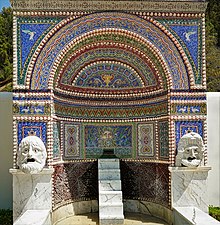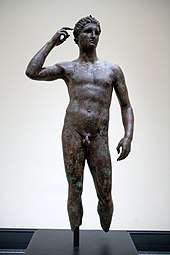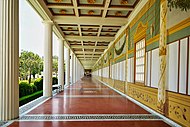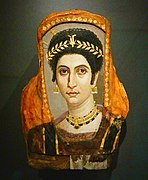Are the Fountains at the Getty Villa on Again
 | |
 | |
 | |
| Established | 1954, reopened 2006 |
|---|---|
| Location | 17985 Pacific Coast Highway, Pacific Palisades, California |
| Coordinates | 34°02′42″N 118°33′54″Due west / 34.0450085°Due north 118.5650826°W / 34.0450085; -118.5650826 Coordinates: 34°02′42″N 118°33′54″West / 34.0450085°North 118.5650826°Westward / 34.0450085; -118.5650826 |
| Blazon | Art museum |
| Collection size | 44,000 Greek, Roman, and Etruscan antiquities |
| Visitors | 453,902 (2016)[1] |
| Director | Timothy Potts |
| Public transit access | Annotation: Ticket must exist punched by bus operator in club to enter the Getty Villa |
| Website | www |
The Getty Villa is at the easterly finish of the Malibu coast in the Pacific Palisades neighborhood of Los Angeles, California, Us.[2] One of two campuses of the J. Paul Getty Museum, the Getty Villa is an educational center and museum defended to the study of the arts and cultures of aboriginal Greece, Rome, and Etruria. The drove has 44,000 Greek, Roman, and Etruscan antiquities dating from 6,500 BC to 400 Advertising, including the Lansdowne Heracles and the Victorious Youth. The UCLA/Getty Main's Programme in Archaeological and Ethnographic Conservation is housed on this campus.
History [edit]

The archway to the Getty Villa sets the tone of inbound an archaeological dig.
In 1954, oil tycoon J. Paul Getty opened a gallery side by side to his habitation in Pacific Palisades.[three] [4] [five] Quickly running out of room, he congenital a 2d museum, the Getty Villa, on the holding downward the hill from the original gallery.[four] [6] The villa pattern was inspired by the Villa of the Papyri at Herculaneum[6] and incorporated additional details from several other ancient sites.[vii] It was designed by architects Robert East. Langdon, Jr., and Ernest C. Wilson, Jr., in consultation with archeologist Norman Neuerburg.[viii] [9] It opened in 1974,[ten] but was never visited by Getty, who died in 1976.[5] Following his death, the museum inherited $661 million[eleven] and began planning a much larger campus, the Getty Centre, in nearby Brentwood. The museum overcame neighborhood opposition to its new campus programme by agreeing to limit the full size of the development on the Getty Centre site.[12] To meet the museum's full infinite needs, the museum decided to split betwixt the 2 locations with the Getty Villa housing the Greek, Roman, and Etruscan antiquities.[12] In 1993, the Getty Trust selected the Boston architects Rodolfo Machado and Jorge Silvetti to pattern a renovation of the Getty Villa and its campus.[12] In 1997, portions of the museum'due south collection of Greek, Roman and Etruscan antiquities were moved to the Getty Center for brandish, and the Getty Villa was closed for renovation.[13] The collection was restored during the renovation.[10]
In 2004, during the renovation, the museum and the University of California, Los Angeles (UCLA) began belongings summer institutes in Turkey, studying the conservation of Middle Eastern Art.[14]
Reopened on January 28, 2006, the Getty Villa shows Greek, Roman, and Etruscan antiquities within Roman-inspired architecture and surrounded by Roman-style gardens.[15] The art is arranged by themes, e.m., Gods and Goddesses, Dionysos and the Theater, and Stories of the Trojan State of war.[15] The new architectural programme surrounding the Villa – which was conceived past Machado and Silvetti Associates (who were also responsible for the plans for the renovated museum) – is designed to simulate an archaeological dig. Architectural Record has praised their work on the Getty Villa equally "a well-nigh miracle – a museum that elicits no smirks from the art earth ... a masterful job ... crafting a sophisticated ensemble of buildings, plazas, and landscaping that finally provides a real abode for a relic of another time and place."[16]
In 2016–18 the collection was reinstalled in a chronological organisation emphasizing art-historical themes.[17]
There has been controversy surrounding the Greek and Italian governments' claim that objects in the drove were looted and should be repatriated.[18] In 2006, the Getty returned or promised to return iv looted objects to Greece: a stele (grave marker), a marble relief, a gold funerary wreath, and a marble statue.[19] In 2007, the Getty signed an agreement to return 40 looted items to Italy.[twenty] [21]
The building was closed to visitors in mid-March 2020, but every bit of 5 June 2021 is now open to the public again.
Facility and programs [edit]

The Getty Villa hosts alive performances in both its indoor auditorium and its outdoor theatre. Indoor play-readings included The Trojan Women, Aristophanes' The Frogs, and Euripides' Helen.[22] Indoor musical performances, which typically chronicle to art exhibits, included: Musica Angelica, De Organographia, and Songs from the Fifth Age: Sones de México in Concert.[23] The auditorium also held a public reading of Homer's Iliad.[24] Outdoor performances included Aristophanes' Peace, Aeschylus'southward Agamemnon, and Sophocles' Elektra.[25] The Getty Villa likewise hosts visiting exhibitions across its ain collections. For example, in March 2011 "In Search of Biblical Lands" was a photographic exhibition which included scenes of the Middle East dating back to the 1840s.[26]
The Getty Villa offers special educational programs for children. A special Family unit Forum gallery offers activities including decorating Greek vases and projecting shadows onto a screen that represents a Greek urn. The room as well has polystyrene props from Greek and Roman culture for children to handle and utilize to cast shadows. The Getty Villa also offers children's guides to the other exhibits.[27] [28]
The Getty Conservation Institute offers a Master'south Plan in Archaeological and Ethnographic Conservation in association with the Cotsen Institute of Archæology at UCLA. Classes and research are conducted in the museum wing of the ranch house. The program was the beginning of its kind in the United states.[29]
Campus [edit]

Aerial view of Getty Villa (building with red roof at eye right) and surrounding area.
The Villa self-identifies with Malibu every bit it is located only eastward of the city limits of Malibu in the city of Los Angeles in the community of Pacific Palisades.[13] [30] [31] [32] [33] [34] The 64 acres (26 ha) museum complex sits on a colina overlooking the Pacific Body of water, which is about 100 feet (thirty thousand) from the entrance to the property. An outdoor 2,500-square-foot (230 grand2) entry pavilion is too built into the hill near the 248-automobile, 4 story, South Parking garage at the southern end of the Outer Peristyle.[35] To the west of the Museum is a 450-seat outdoor Greek theater where evening performances are staged, named in honor of Barbara and Lawrence Fleischman.[35] The theater faces the w side of the Villa and uses its archway as a stage.[36] To the northwest of the theatre is a 3-story, xv,500-square-human foot (1,440 k2) building built into the hill that contains the museum store on the lower level, a cafe on the second level, and a private dining room on the top level.[37] North of the Villa is a ten,000 sq ft (930 chiliad2) indoor 250-seat auditorium.[35] On the hill above the museum are Getty's original private ranch house and the museum wing that Getty added to his abode in 1954. They are now used for curatorial offices, coming together rooms and as a library.[4] Although non open up to the public, the campus includes J. Paul Getty'south grave on the hill behind his ranch house.[38] A 200-motorcar N Parking Garage is behind the ranch complex. The 105,500-square-foot (9,800 gtwo) museum building is bundled in a foursquare opening into the Inner Peristyle courtyard. The 2006 museum renovation added 58 windows facing the Inner Peristyle and a retractable skylight over the atrium.[sixteen] Information technology also replaced the terrazzo floors in the galleries and added seismic protection with new steel reinforcing beams and new isolators in the bases of statues and display cases.[10] The museum has 48,000 sq ft (4,500 m2) of gallery space.[35] [39]
Writing in 2008, the architectural critic Calum Storrie described the overall upshot:
What the Getty Villa achieves, first by seclusion, then by control of access, and ultimately through the architecture, is a sense of detachment from its immediate environs.[xl]
Gardens [edit]
There are four different gardens on the grounds of the Getty Villa, planted with plants native to the Mediterranean and known to take been cultivated past the ancient Romans.[41] The largest garden is that of the Outer Peristyle, an exact proportional replica of the one at the Villa dei Papiri. The garden is 308 by 105 anxiety (94 m × 32 m), with a 220 feet (67 m) long pool at the center. Traditional Roman landscaping designs are replicated with manicured bay laurel, boxwood, oleander, and viburnum shrubs. In that location are rows of date palms lining each of the long sides of the Outer Peristyle garden, while each corner features pomegranate copse surrounded by ornamental plants like acanthus, ivy, hellebore, lavender, and iris.[42] : 91 Copies of Roman bronzes excavated at the Villa dei Papiri and elsewhere are scattered throughout the garden.

Just west of the Outer Peristyle is the Herb Garden, where traditional herbs sourced from ancient Roman texts are cultivated along with a variety of fruit trees: pomegranate, fig, apricot, apple, citrus, and pear. The garden is surrounded by grapevines, and bounded by an olive grove planted on terraces in a higher place the garden.[42] : 100 The Due east Garden is small and secluded, surrounded by laurel and plane trees.[41] Its master characteristic is an verbal replica of the famous beat out and mosaic fountain at the Business firm of the Bang-up Fountain in Pompeii, simply there is also a circular fountain at the center of a basin filled with aquatic plants, around which the garden is oriented.[42] : 84–85 The fourth and last garden is that of the Inner Peristyle. Like the Outer Peristyle, a long, narrow, marble lined pool forms the centerpiece of the landscaping; along each side are replicas of bronze female statues from the Villa dei Papiri, modelled to announced as if they are drawing water from the pool. In each corner of the garden is a replica white marble fountain, and there are besides several statuary copies of famous Greek sculptures similar the Doryphoros and busts of Greek philosophers similar Pythagoras and Democritus.[42] : 68–69
Collection [edit]

The collection has 44,000 Greek, Roman, and Etruscan antiquities dating from six,500 BC to 400 AD,[43] of which approximately i,400 are on view.[44]
Among the outstanding items is Victorious Youth, 1 of few life-size Greek bronze statues to have survived to modern times.[6] [45] The Lansdowne Heracles is a Hadrianic Roman sculpture in the style of Lysippus.[46] The Villa besides has jewelry and coin collections[18] and an extensive 20,000 volume library of books covering art from these periods.[47] The Villa as well displays the Getty kouros, which the museum lists as "Greek, almost 530 B.C., or modern forgery" because scientific assay is inconclusive as to whether the marble statue can exist dated to Greek times.[36] [48] If genuine, the Getty kouros is i of only twelve remaining intact lifesize kouroi.[49] The Marbury Hall Zeus is an 81 in (2.1 m) tall marble statue that was recovered from ruins at Tivoli about Rome.[50]
GettyGuide [edit]
Detailed information most the J. Paul Getty Museum's collection at the Getty Villa is provided on "GettyGuide". This is available both at the Museum, at diverse points known as "GettyGuide stations", and externally on its website.[51]
Gallery [edit]
-

Outer Peristyle
-

Outer Peristyle - architectural item
-

Inner Peristyle
-

Gallery within the Villa
-
The Lansdowne Herakles, part of the museum'south drove
-

Athena, Goddess of war, culture, wisdom, strength, strategy, crafts, justice and skill
-

Roman-Egyptian Female Mummy Portrait
-

Roman gold medallion
-

Roman bronze statuette
-

Roman fresco fragment of a peacock
-

Roman head-shaped glass vessels
-

Venus and Eros in Marble Room
-

Statue of a Siren
-

Roman bronze statue of Apollo
Come across besides [edit]
- Camillo Paderni described parts the Villa of the Papyri
Notes [edit]
- ^ "Visitor Figures 2016" (PDF). The Art Newspaper Review. April 2017. p. 14. Retrieved 23 March 2018.
- ^ "About the Museum (Getty Museum)". www.getty.edu . Retrieved 2016-01-nineteen .
- ^ Storrie at p. 186.
- ^ a b c "Architecture". Getty Trust. Retrieved 2011-03-08 .
- ^ a b Bird, Cricket (June x, 1976). "Getty Never Saw Fabled Museum". Lewiston [Maine] Evening Journal. p. 10. Retrieved 2011-03-08 .
- ^ a b c Ray, Derek (Feb 11, 2011). "The Getty Middle and the Getty Villa". San Diego Reader . Retrieved 2011-03-02 .
- ^ Muchnic, Suzanne (2019-12-06). "Stephen Garrett, architect and first director of Malibu'south Getty Villa, dies". Los Angeles Times . Retrieved 2019-12-eleven .
- ^ Myrna Oliver, Robert Langdon Jr., 86; Designed 1st Getty Museum, The Los Angeles Times, August 25, 2004
- ^ Grad student unearths architect's drawings for Getty exhibition, USC School of Architecture: School News, July 05, 2013
- ^ a b c Moltesen at p. 155.
- ^ Lenzner, Robert. The great Getty: the life and loves of J. Paul Getty, richest man in the world. New York: Crown Publishers, 1985. ISBN 0517562227
- ^ a b c Filler at 215.
- ^ a b Schultz, Patricia (2003). Ane chiliad places to encounter before y'all die. Workman Publishing. p. 575. ISBN978-0761104841.
- ^ "UCLA and Getty Museum Hold Summer Constitute in Turkey". UCLA. 2004-09-23. Archived from the original on 2011-07-20. Retrieved 2010-12-30 .
- ^ a b Moltesen at 157.
- ^ a b Pearson, Clifford A. (May 2006). "Machado and Silvetti creates an elaborate new setting that shows off the renovated Getty Villa without irony or apologies". Architectural Record. The McGraw-Hill Companies, Inc. Retrieved 2010-05-15 .
- ^ Potts, Timothy (April 2, 2018). "A New Vision for the Collection at the Getty Villa". The Getty Iris. J. Paul Getty Trust. Retrieved April thirteen, 2018.
- ^ a b Rogers, John (January 27, 2006). "Getty Museum reopening its much renovated villa". Seattle Times . Retrieved 2011-03-02 .
- ^ Carassava, Anthee. Greeks Hail Getty Museum's Pledge to Return Treasures. New York Times, December 12, 2006. Retrieved September 3, 2008.
- ^ Povoledo, Elisabetta. Italia and Getty Sign Pact on Artifacts. New York Times, 2007-09-26. Retrieved 2008-09-03.
- ^ Filler at pp. 221–23.
- ^ "Villa Play–Reading Series". Getty Trust. Retrieved 2011-03-11 .
- ^ "Concerts at the Villa". Getty Trust. Retrieved 2011-03-11 .
- ^ "Public Reading of Homer's Iliad". Getty Trust. Retrieved 2011-03-11 .
- ^ "Getty Villa Outdoor Theater Production". Getty Trust. Retrieved 2011-03-11 .
- ^ "Agenda Picks and Clicks". Jewish Periodical. March 1, 2011. Retrieved 2011-03-08 .
- ^ "Family unit Forum". Getty Trust. Retrieved 2011-03-08 .
- ^ Moltesen at p. 156.
- ^ "Getty Villa Press Kit" (PDF). Getty Trust. Archived from the original (PDF) on 2012-10-08. Retrieved 2010-12-30 .
- ^ E.g., Storrie at p. 186; Moltesen at p. 155.
- ^ Greenberg, Mark (2005). Guide to the Getty Villa. Getty Trust. p. 131. ISBN978-0892368280.
- ^ "Visit the Getty". Getty Trust. Retrieved 2011-03-08 .
- ^ "Visit". The J. Paul Getty Trust.
- ^ Jaffee, Matthew (May 2007). "Posh Pacific Palisades". Sunset magazine. Archived from the original on November 24, 2007. Retrieved September iii, 2008.
- ^ a b c d "Fact Sheet" (PDF). Getty Trust. Archived from the original (PDF) on 2012-10-08. Retrieved 2010-12-xxx .
- ^ a b Filler at p. 221.
- ^ Filler at p. 220
- ^ Patricia Brooks, Jonathan Brooks (2006). Laid to Rest in California: A Guide to the Cemeteries and Grave Sites of the Rich and Famous. Globe Pequot. p. 208. ISBN978-0762741014 . Retrieved 2011-03-08 .
{{cite volume}}: CS1 maint: uses authors parameter (link) - ^ Map & Guide to the Getty Villa, Getty Trust, May 2010
- ^ Storrie at p. 187
- ^ a b "Gardens". world wide web.getty.edu. Retrieved 2019-10-10 .
- ^ a b c d Guide to the Getty Villa. Getty Publications. 2005.
- ^ "Art (Visit the Getty Villa)". Getty Trust. Retrieved 2018-04-13 .
- ^ Spier, Jeffrey (April xi, 2018). "What'south New to Explore in the Reinstalled Getty Villa Galleries". The Getty Iris. J. Paul Getty Trust. Retrieved Apr 13, 2018.
- ^ "Victorious Youth". Getty Trust. Archived from the original on 2010-12-03. Retrieved 2011-02-28 .
- ^ "Lansdowne Herakles". Getty Trust. Archived from the original on 2011-05-04. Retrieved 2011-02-28 .
- ^ "Research Libraries". Getty Trust. Retrieved 2011-02-28 .
- ^ "Statue of a Kouros". Getty Trust. Retrieved 2011-02-28 .
- ^ Robert Bianchi, "Saga of The Getty Kouros", Archaeology (May/June 1994).
- ^ "Marbury Hall Zeus". Getty Trust. Retrieved 2011-02-28 .
- ^ GettyGuide – Getty.edu Retrieved September 3, 2008.
References [edit]
- Filler, Martin (2007). Makers of mod compages . New York Review of Books. ISBN978-1590172278.
- Moltesen, Mette (January 2007). "The Reopened Getty Villa". American Periodical of Archaeology. Boston University, Boston Massachusetts: The Archaeological Institute of America. 111 (1): 155–59. doi:x.3764/aja.111.1.155. ISSN 0002-9114.
- Storrie, Calum (2008). The Delirious Museum: A Journey from the Louvre to Las Vegas. I.B.Tauris. ISBN978-1845115098.
External links [edit]
- Getty.edu: official Getty Villa website
- Getty.edu: J. Paul Getty Trust website
- J Paul Getty Museum – GNIS information
- Vimeo.com: four-part documentary video nigh the Getty Villa and its Roman model, the Villa of the Papyri
- Flickr.com: photos tagged with "Getty Villa"
lathamtheighty1943.blogspot.com
Source: https://en.wikipedia.org/wiki/Getty_Villa

0 Response to "Are the Fountains at the Getty Villa on Again"
Enregistrer un commentaire